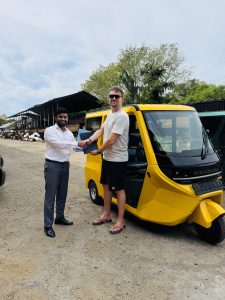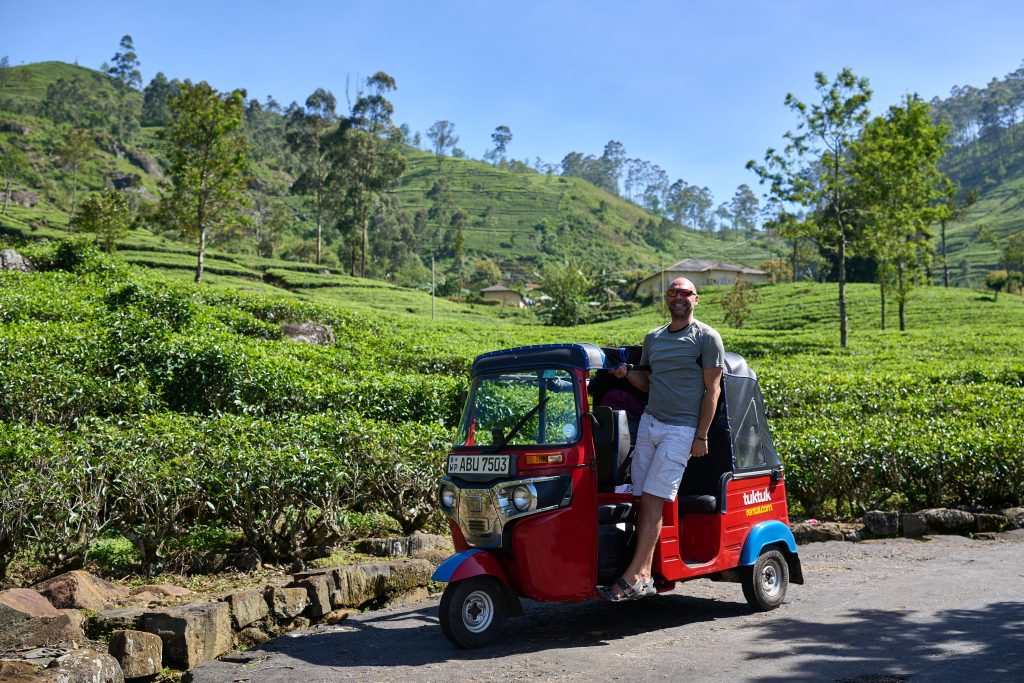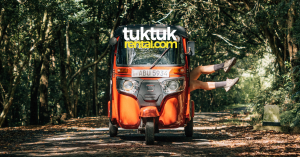Renting a Tuktuk in Sri Lanka: The Ultimate Guide 2025
Author: Avantika Chaturvedi
Imagine the wind in your hair, the scent of fresh spices in the air, and the thrill of navigating winding coastal roads at your own pace. Renting a tuktuk in Sri Lanka is not just about transportation; it is about getting to know Sri Lanka from the ground level, from a perspective that very few travellers have experienced.
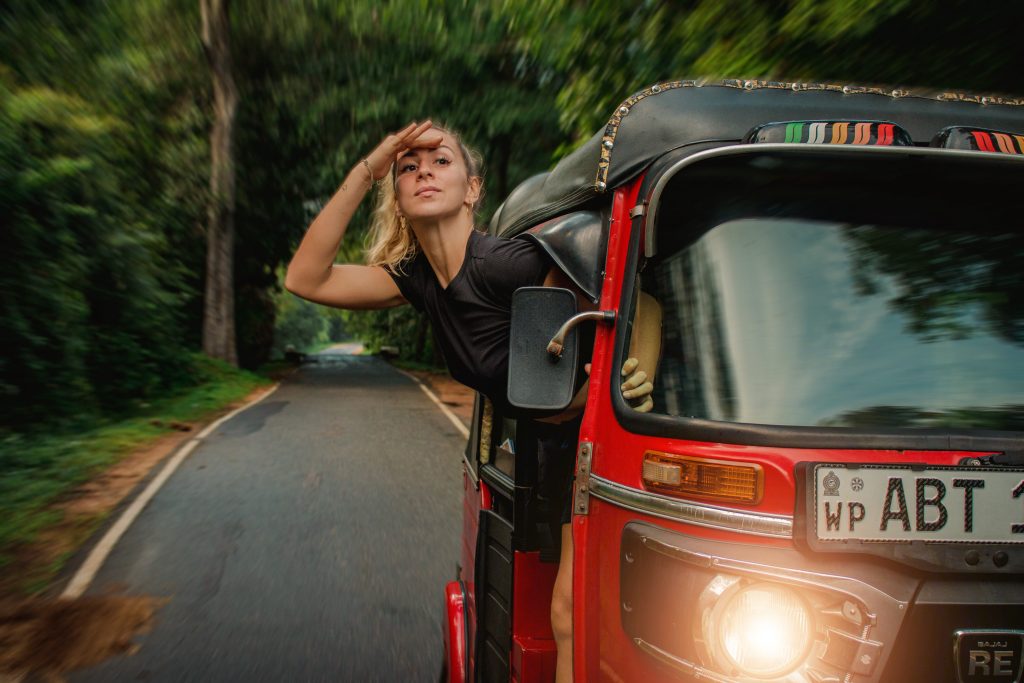
The tuktuk has long been associated as the “poor man’s vehicle” in Sri Lanka. So when you, a foreign visitor, hop on and take control of these three wheels, it opens new portals of communication and cultural exchange with the locals and their country. And of course, renting a tuktuk also affords you the freedom to explore hidden beaches, remote villages, and scenic mountain routes that many travellers never see.
Whether you’re a backpacker craving an adventure, a digital nomad seeking flexible travel, or a cultural enthusiast looking to connect with locals, renting a tuktuk is for all kinds of travellers and fits many different travel styles. This guide will help you navigate everything you need to know about renting a tuktuk in Sri Lanka – including a driver’s permit, tuktuk driving lessons, traffic laws, driving tips, itinerary recommendations and more.
Why Rent a Tuktuk in Sri Lanka?
Sri Lanka is one of the very few countries in the world where you can rent a tuktuk for personal use to explore the country on a road trip. This exclusivity definitely makes it the top reason to rent a tuktuk in Sri Lanka in our modest opinion. But have a look at some even more compelling arguments to make our case!
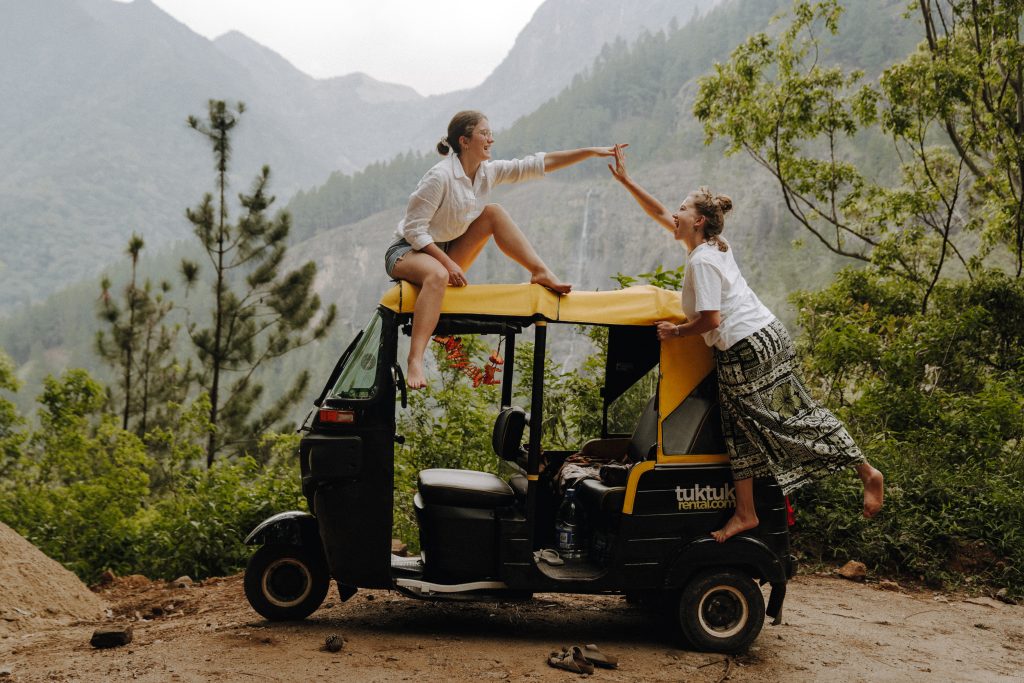
Ultimate Freedom and Flexibility
A tuktuk allows you to travel on your own terms, stopping wherever and whenever you like. Unlike buses and trains with fixed schedules and stopping points, a rented tuktuk lets you explore remote waterfalls, quiet jungle roads, and off-the-beaten-path villages – everything Sri Lanka is best known for, at your own pace. And unlike renting a bike, you do not have to worry about taking on more than 2 riders, or even the lack of storage space. The tuktuk solves it all for you!
An Unforgettable Adventure
We said it before, and we will say it again: driving a tuktuk is more than just mere transportation, it is a whole experience in itself – one that blends adventure, fun, and a touch of a challenge to keep you on your toes. Manoeuvring through chaotic city streets and cruising along empty coastal highways offers an unparalleled adventure that you are sure to remember for ages to come. And it also makes for one hell of a story!
Budget Friendly Travel
Renting a tuktuk can be surprisingly economical, especially if you are travelling as a couple or a group. Splitting costs on fuel and rental fees often makes it more affordable than hiring private drivers or using taxis wherever you go.
Deep Cultural Immersion
Tuktuks are a staple of Sri Lankan daily life. Renting one lets you experience the country as locals do, sparking conversations at roadside tea stalls, navigating village roads, and gaining access to places unreachable by public transport. Raw, offbeat travellers love it for this one!
Instagrammable Photo Opportunities
Lastly, a tuktuk road trip allows for some undeniably awesome photo opportunities that no train or bus can get you. The tuktuk itself is a photogenic subject against the panoramic views of Sri Lanka’s breathtaking scenery. Add to that the flexibility to stop anywhere, anytime you want, and you will have some brilliant footage for that social media photo dump!
How to Rent a Tuktuk in Sri Lanka
Choose a Reputable Rental Company
As the popularity of renting a tuktuk in Sri Lanka is on the rise, many rental agencies have sprung up over the years. Some of them, unfortunately, often do not meet the minimum safety standards and put your lives at risk in the name of cheaper prices. That is why choosing a reliable operator is important.
This is where we, Tuktuk Rental come in:
- We are the first tuktuk rental company in Sri Lanka with close to a decade of experience under our belt.
- Our fleet of tuktuks is in prime condition with regularly serviced vehicles, a factor missing in many other rental companies.
- We offer end-to-end solutions by providing reliable vehicles, trip planning, driving lessons, insurance, proper licensing assistance, accessory add-ons, various pick-up and drop-off locations and many other services.
- We have 24×7 customer support available via WhatsApp and local calling, and also have recommended tuktuk mechanics in most tourist towns across Sri Lanka.
- We have a special fleet of Cabrio (convertible) tuktuks and electric tuktuks too.
- We offer a variety of add-ons for your tuktuk, including surfboard racks, baby seats, Bluetooth speakers, and more.
Most importantly, we are a social enterprise. We do not own any vehicles and simply rent the tuktuks from their local owners at fair prices. A win – win – win situation indeed!
Requirements for Renting a Tuktuk
To rent a tuktuk legally in Sri Lanka, you will need:
- A valid international driving permit (IDP) with a category for motorcycles or light vehicles.
As of 30 March 2025, the Automobile Association of Ceylon requires you to have an International Driving Permit (IDP) to process your Sri Lankan Recognition Permit. If you are in your home country, we recommend obtaining an IDP before you travel.
But if you are unable to obtain a physical document in your home country? In that case, you can apply for an E-IDP and get free express delivery by entering the code ‘TUKTUKEXPRESS’. *Select express delivery and the coupon box will appear.
- A Sri Lankan driving permit, which we can help you obtain
- A copy of your passport
- Your passport-size photo (you can take that at our office)
- A spirit for adventure!
Tuktuk Rental Costs and Inclusions
Rental prices vary based on duration, the month of renting, accessory add-ons and type of tuktuk (electric/ Cabrio). Our base prices generally range from $14 to $28 per day. This includes:
- Unlimited mileage
- Comprehensive insurance
- Driving lessons
- Maps and recommended routes
- 24×7 roadside
- Phone holders
- USD chargers
You can further customize your tuktuk rental by adding accessories like baby seats, Bluetooth speakers, ice coolers, surfboard racks and more.
Driving a Tuktuk in Sri Lanka: What to Expect
Learning to Drive a Tuktuk in Sri Lanka
If you have never driven a tuktuk before, don’t worry! Comprehensive tuktuk driving lessons are included when you rent with us. These lessons are designed to help you get comfortable with handling, braking, and manoeuvring in traffic. Our driving gurus help even the most nervous drivers get a hang of it pretty quickly!
Understanding Sri Lankan Road Rules
- Sri Lanka drives on the left side of the road.
- Use the horn liberally. In Sri Lanka, the horn is a communication tool, not aggression!
- Watch for unexpected obstacles like cows, dogs, potholes and pedestrians.
Avoid driving at night, as roads can be poorly lit and unpredictable.
Fueling Up and Maintenance (Fuel capacity of a Tuktuk)
Tuktuks run on petrol and have small, 7 litre tanks, plus 1.5 litres on reserve. So refuelling every 100 to 120 kilometres or so is usually ideal. Petrol stations are common in major towns and cities but can be scarcer in rural areas, so it is better to plan ahead. However, if you do run out of fuel unexpectedly, try asking around in local general stores. They usually have some fuel to spare at an added cost.
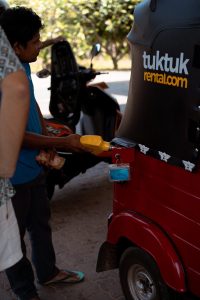
Best Tuktuk Road Trip Routes in Sri Lanka
Southern Coast Adventure (Colombo to Tangalle)
The southern coast is perhaps Sri Lanka’s most prized tourist district. From charming colonial towns and quaint coastal villages to incredible surf and even spectacular scuba diving, this coast has it all. The mostly well-paved coastal roads are always an added bonus!
Sri Lanka South Coast highlights:
- Scuba diving in Colombo
- Paramotoring in Bentota
- Walking around Galle Fort
- Snorkelling at Unawatuna Beach
- Whale watching in Mirissa
- Surfing at Hiriketiya and Welligama
- Kayaking at Tangalle Lagoon
Hill Country Escape (Kandy to Ella)
If winding, misty roads, tea plantations, colonial buildings, sweeping waterfalls and beautiful hikes in a tropical rainforest are more your jam, you are sure to enjoy your time in the Central Highlands of Sri Lanka!
Hill Country highlights:
- Tea plantations of Kandy
- Waterfalls around Nuwara Eliya
- Nine Arches Bridge in Ella
- Hortons Plains National Park
- Hiking in the Knuckles Mountain Range
- The iconic train ride from Kandy to Ella
Cultural Triangle (Sigiriya, Dambulla & Anuradhapura)
Sri Lanka’s Cultural Triangle is a treasure trove of ancient history, sacred sites, and architectural wonders. It encompasses the UNESCO World Heritage cultural sites of Anuradhapura, Polonnaruwa, Sigiriya, Dambulla, and Kandy. The triangle showcases the island’s rich heritage and offers a deep dive into its past, making it a must-visit for history and culture enthusiasts.
Cultural Triangle highlights:
- Sigiriya Rock Fortress
- Archaeological relic city of Polonnaruwa
- Ancient temples of Anuradhapura
- Cave Temple at Dambulla
- Temple of the Sacred Tooth Relic in Kandy
Northern Exploration (Jaffna & Surrounds)
Northern Sri Lanka, along with the Jaffna Peninsula, is the land of rich Tamil heritage, unspoiled beaches, colourful Hindu temples and unique cuisine. like, colonial-era architecture, and a unique cuisine. Slowly emerging from decades of conflict, Northern Sri Lanka offers an offbeat, deeply cultural experience, blending history, tradition, and warm hospitality.
Northern Sri Lanka highlights:
- Nallur Kandaswamy Kovil in Jaffna
- Delft Island ruins
- Casuarina Beach
- Keerimalai Springs
- Vankalai Bird Sanctuary
- Dishes like crab curry and Jaffna kool
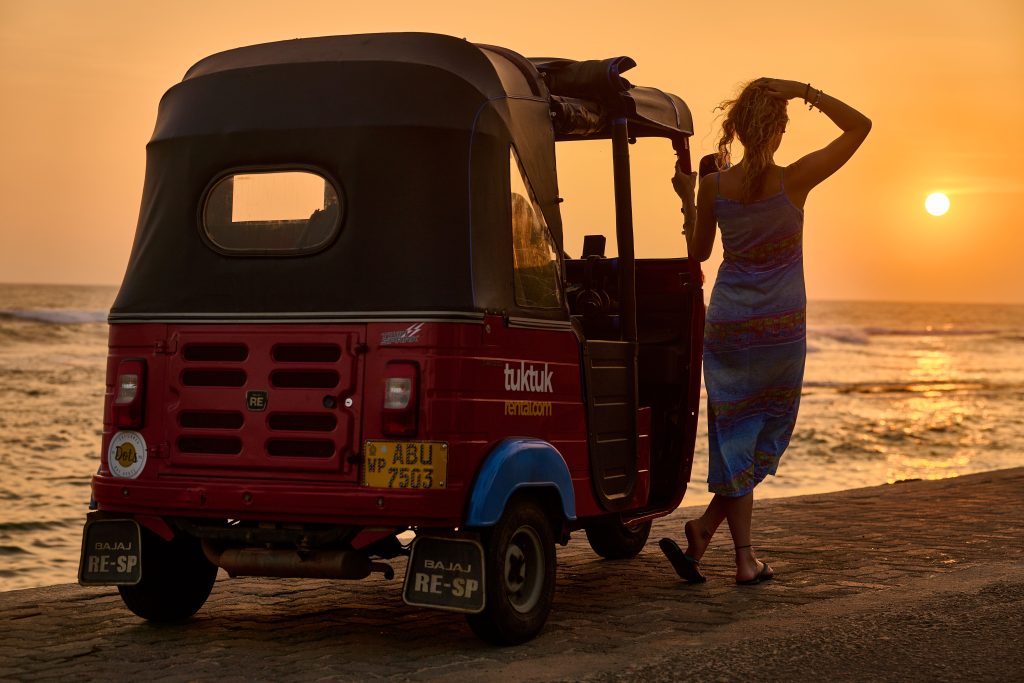
East Coast Paradise (Trincomalee to Arugam Bay)
Sri Lanka’s East Coast is a sun drenched paradise known for its pristine beaches, laid back vibe, world class surf breaks and diverse marine life. With a blend of Tamil, Muslim, and Sinhalese influences, the East Coast is a hidden gem for travelers seeking adventure, culture and uninterrupted beach time.
East Coast highlights:
- Whale and dolphin watching in Trincomalee
- Scuba diving and snorkelling in Nilaveli and Pigeon Island
- Surfing in Arugam Bay
- Wildlife safari in Kumana National Park.
- Surfing in Arugam Bay
- Swimming in Passikudah Beach
Tuktukrental’s free trip planning sessions are also a great resource to best plan your itinerary according to your needs, interests and the island’s weather conditions during your travel dates.
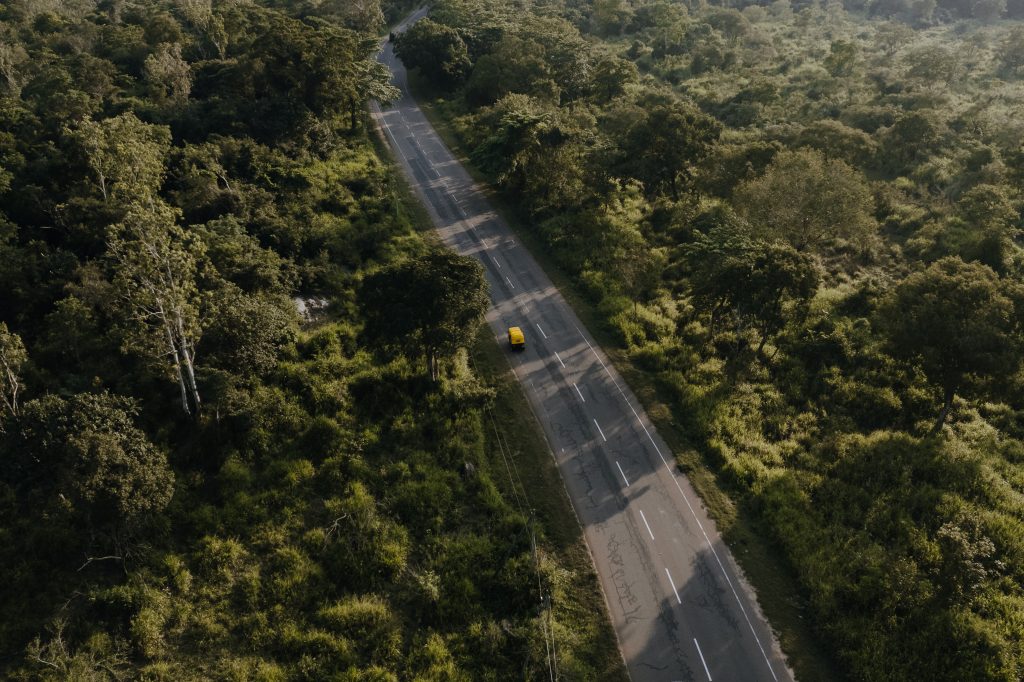
Essential Tips for a Smooth Tuktuk Adventure
Download Offline Maps
Google Maps and Maps.me are lifesavers when navigating Sri Lanka’s smaller roads where signage and mobile internet can be scarce.
You might also consider downloading the Tuktukrental Travel App. It features offline maps, offbeat recommendations and even helps fellow tuktuk-ers on the road connect for information or just a few post drive beers – or the local Sri Lankan arrack if you are feeling adventurous!
Carry Cash for Fuel and Small Expenses
Many rural areas lack card payment facilities, so keep small denominations handy. ATMs, however, are readily available everywhere.
Be Weather-Prepared
Sri Lanka’s tropical climate means sudden rain showers. Pack a waterproof cover for your bags and a light rain jacket. Central Highlands can also get unexpectedly cold, especially during the winter months of November through January. So carrying some light woolens would be ideal.
Respect Local Culture
Most religious sites in Sri Lanka require both men and women to cover their shoulders and knees. So keep a jacket or scarf/ sarong handy.
Renting a Tuktuk in Sri Lanka: Frequently Asked Questions
Can foreigners drive a tuktuk in Sri Lanka?
Yes! Foreigners can drive a tuktuk – or a car or bike for that matter – in Sri Lanka. You need to have a Sri Lankan driving permit, which can be easily obtained if you have an International Driving Permit (IDP) or your national driver’s license.
How many people can fit in a tuktuk?
A maximum of four people (three in the back, one driver) can fit in a tuktuk. However, for a comfortable and relaxed journey, it is advisable to have no more than two people in the back.
Are tuktuks easy to drive?
Tuktuks are quite easy to drive, especially if you have driven a car or motorbike before. Renting a tuktuk with Tuktukrental gets you free comprehensive driving lessons which are sure to turn you into a confident tuktuk driver!
Is renting a tuk tuk in Sri Lanka safe?
Renting a tuktuk in Sri Lanka is safe if you adhere to the traffic laws and driving norms. It is also important to choose your tuktuk rental company wisely to ensure a fully serviced, functional vehicle.
Read more about Ruby Marshall’s tuktuk adventure in Sri Lanka, and why you shouldn’t be scared to rent and drive a tuktuk around Sri Lanka.
How tall can you be to drive a tuktuk?
On an average, a person as tall as 6 feet, 5 inches (195 centimeters) can easily survive driving the tuktuk every day for about 5 hours. However, this also varies depending on your posture, how you sit and overall personal tolerance.
Watch this video of Annabelle, a 6’3” Dutch woman’s experience renting a tuktuk in Sri Lanka!
For taller people, the most comfortable ride will be our Electrotuk (electric tuktuks) which are comparatively bigger than the regular tuktuks.
